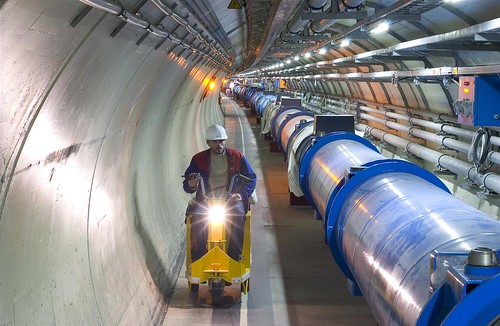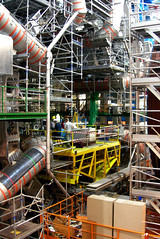 |
A small portion of the Large Hadron Collider at CERN, in Switzerland. Flickr photo by Ars Electronica. |
Scientists at the European Organization for Nuclear Research (known by its French acronym, CERN), announced in a paper to be released soon that they had measured subatomic particles that seemed to travel faster than light. Essentially, scientists launched neutrinos from a source near Geneva, Switzerland, to a detector in Italy about 453 miles away. The neutrinos arrived 60 nanoseconds (0.00000006 seconds) faster than a photon (the particle [or wave] that makes up light) would have.
First, this discovery is somewhat shocking because it violates Einstein's theory of special relativity (you know, "e=mc squared"), which states nothing can travel faster than light. Relativity has been proven correct in experiment after experiment for more than 100 years. It's as if someone told Newton that there wasn't an equal but opposite reaction after every action.
 |
| Part of the CERN research center. Flickr photo by dirtybronson. |
One might ask, "OK, but why is this important?" There are several reasons, although the ultimate effects -- if the experiment pans out -- might not be seen for years, if not centuries. Certainly, the everyday life of people alive today is unlikely to be affected. But the long-term effects may be enormous:
- First, the implications for computing are significant. Think quantum computing will be fast? Then, what about computers that solve problems almost before they're entered?
- What about astronomy? If neutrinos can go faster than light, one day we might have detectors that can almost literally see back in time to the beginning of the universe.
- And not even finally, but perhaps most profoundly, neutrinos going faster than light means that information (although probably not objects) can also be sent faster than light. If mankind is not alone (and with billions of galaxies containing billions of stars, being alone is unlikely), then we might have the means to communicate with other beings in a reasonable time frame.
But the best part of this business is how it demonstrates the scientific method. These scientists came up with an idea, tested and experimented it into a hypothesis (that neutrinos can travel faster than light under some circumstances), and submitted their work to be peer reviewed for more experimentation en route to forming a theory. In fact, they basically pleaded with scientists from the United States, Japan and other scientifically advanced countries to try to replicate their experiment to make sure they didn't make a mistake.
The results may or may not pan out (probably not, I must admit). But the scientists' efforts at confirmation are a huge relief in times when those on both the left and the right often refuse to recognize the teachings of science because it doesn't fit their social or religious agenda.
Edit (Feb. 22, 2012): It appears that a faulty GPS reading caused the distances between the two sites to be overestimated, accounting for the unexpectedly short time it took for the neutrinos to hit the detector. Again, this shows the wonderfulness of the scientific method and its system of checks and balances.
No comments:
Post a Comment